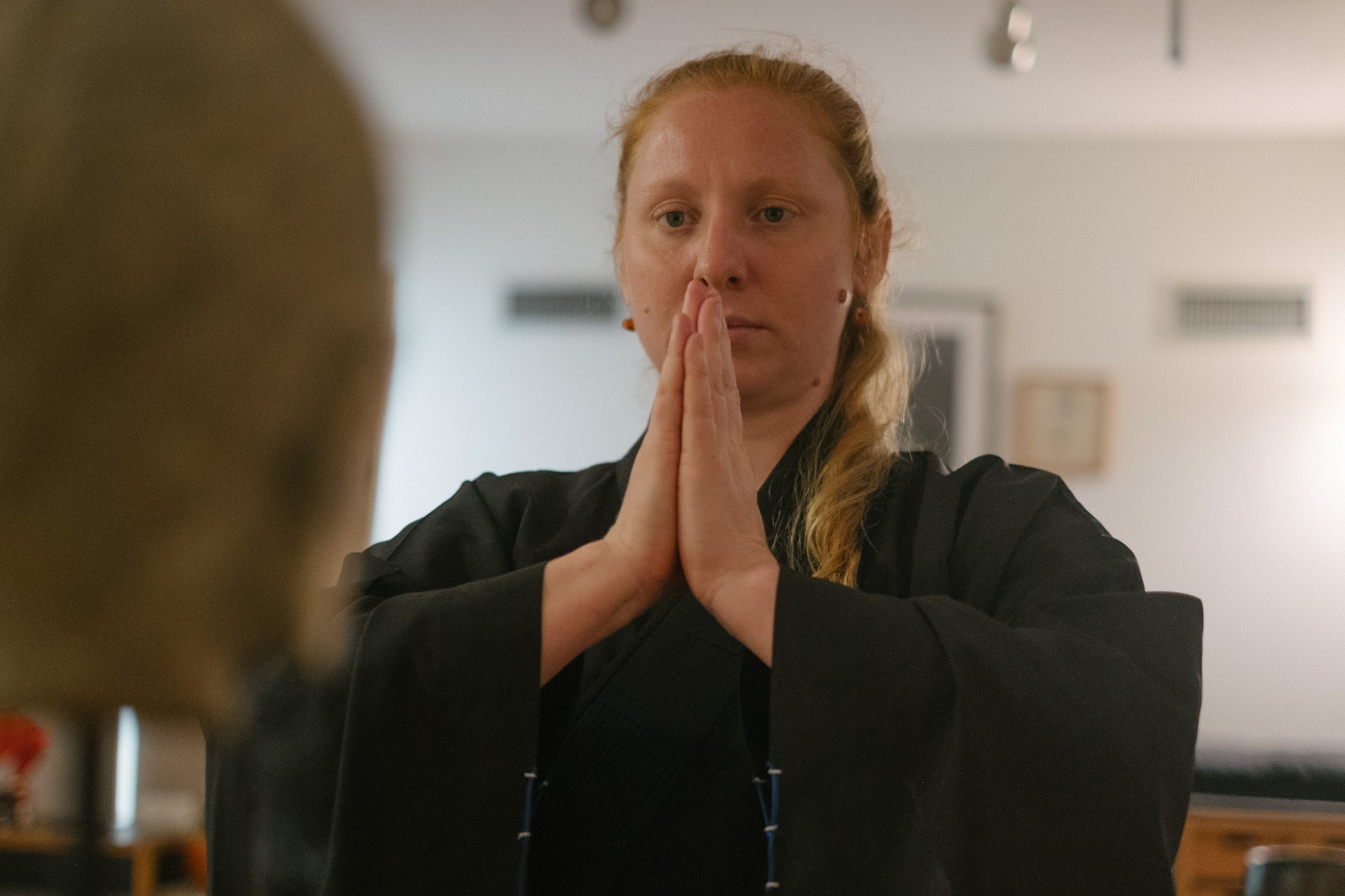Background
John, a native of Long Island, New York, embarked on a transformative spiritual journey that led him to explore meditation and Buddhism. His initial exposure came through Integral Yoga Institute in New York City, but his quest for a deeper understanding of Dharma took him across continents.
In 1971, John traveled through Southern Europe, the Middle East, Africa, and finally arrived in India. During a trek to the base camp of Mount Everest, he encountered Tibetan villages and Buddhist monasteries, where he was introduced to Buddhism. This pivotal moment marked the beginning of John’s profound connection to the teachings.
He continued his spiritual exploration in Southeast Asia, practicing in Burma and Thailand. In Chiang Mai, Thailand, he encountered a Thai temple and the teachings of a monk named Buddha Dossa. Inspired by the profound impact, John journeyed to Wat Suan Mok in Southern Thailand, where he deepened his practice and ordained as a novice and later as a full monk under the guidance of John Donne Madero.
John’s spiritual journey extended to India, where he engaged in intensive meditation practice with Ehsan Goenka. Returning to Thailand, he practiced with renowned teachers like Ajahn Cha at Wat Pa Nanachat and Ajahn Buddha Dassa. His monastic life included periods of solitude, living in caves, and engaging with Hill Tribe communities.
In 1979, John returned to the United States still as a monk. His unexpected entry into teaching began when invited by Joseph Goldstein and Jack Kornfield at the Insight Meditation Society in Massachusetts. Over nine years, he taught at IMS and various centers, transitioning from monkhood to lay practice.
Reflecting on his journey, John emphasized the significance of mindfulness and intensive practice in the Thai Forest tradition. He found a balance between meditation and study, deepening his understanding of sutras. His teaching expanded to include an emphasis on moment-to-moment mindfulness in daily life.
John’s spiritual path unfolded as a fusion of diverse experiences, encounters with various teachers, and immersive practices in different traditions, ultimately shaping him into a seasoned meditation teacher.
Cultural Relevance
John reflects on his unconventional journey, revealing his decision to drop out of college during the Vietnam War era. Motivated by a desire to avoid the draft, he left college, realizing it didn’t align with his search for something deeper. Returning to New York, he delved into yoga and Eastern practices, ultimately leading him to meditation.
As a Western Buddhist monk in Thailand, John found himself navigating two worlds, feeling like a fish out of water upon returning to the United States. He sees this dual experience as integral to the process of moving toward non-duality. Acknowledging the inherent duality of the human experience, he emphasizes the spiritual pursuit of non-separation or non-duality, a process that unfolds gradually.
Drawing from personal experiences with psychedelics, John highlights the challenge of maintaining non-dual awareness after the drug wears off. Motivated to find a more stable awakening, he pursued practices that allowed him to transcend the conditioned mind and experience a sense of unity.
Expressing concern about societal divisiveness, John emphasizes the relevance of Buddha Dharma in addressing suffering and fostering universal consciousness. He believes that connecting to the heart center, tapping into innate loving-kindness, compassion, and forgiveness, is essential for awakening. John underscores the importance of recognizing the universal mantra of love, which, despite external conflicts, connects all of humanity through shared kindness and compassion.
Lineage Foundations
In exploring the journey of spiritual practice, John emphasizes the accessibility of Dharma teachings in the West, highlighting the diverse opportunities to begin the practice of meditation and study Buddhist principles without the need to travel to Asia. Stressing the importance of finding a suitable teacher, community, and practice, John advises newcomers to explore different centers and traditions until they connect with what resonates with them.
Acknowledging the challenges of starting meditation, John encourages the integration of mindfulness stress reduction programs, such as the one initiated by John Kabat-Zinn. He emphasizes the non-secular nature of the practice, focusing on tranquility, insight, and heart-centered approaches. John recognizes the difficulties that arise during meditation, including confronting emotions like fear and anger, and stresses the significance of having a supportive teacher, community, and study resources to navigate these challenges.
John discusses the compatibility of Buddhist teachings with psychological approaches, acknowledging that combining meditation with therapy can be beneficial, particularly in addressing deeper emotional issues. He underscores the importance of ethical considerations, introducing the concept of precepts and their role in emphasizing non-harm in various aspects of life.
Sharing insights from his own experiences, John recounts his journey through different traditions and practices, highlighting the transformative nature of exploring diverse teachings. He encourages practitioners to delve deeply into their chosen path, avoiding shallow engagement. Additionally, John emphasizes the balance between attachment and detachment, drawing from personal experiences of getting attached to specific meditation techniques and the subsequent realization of the impermanence of such experiences.
John concludes by stressing the importance of trusting one’s inner wisdom, allowing the innate qualities of kindness, compassion, and wisdom to unfold. He advocates for a sincere and continuous practice, emphasizing that the essence of spiritual awakening lies within oneself and is nurtured through meditation, study, and cultivating a loving heart.
Emptiness
John delves into the intricacies of Buddha Dharma, particularly the concept of dependent origination. He explains how one thing serves as the cause and condition for the arising of another, creating an interconnected chain of events. Using the example of snowfall, he illustrates how perceptions and feelings lead to mental states, influencing one’s sense of self.
Highlighting the relevance of dependent origination in understanding suffering, John emphasizes its role in recognizing moments of duality and separation within oneself. Through Vipassana practice, he learns to interrupt this chain, fostering a sense of non-duality and interconnectedness.
Expanding beyond personal experiences, John discusses the impact on relationships. He notes the interplay of energy between individuals, emphasizing the importance of mindfulness in maintaining positive connections. His reflections extend to societal and environmental spheres, citing climate change as an example of collective interdependence.
Drawing parallels between Western and Thai culture, John notes the emphasis on individual success in the West versus the collective harmony in Thai culture. He sees Buddha Dharma as a unifying force that has influenced Thai culture’s generosity, hospitality, and sense of community. This universal perspective, according to John, extends beyond personal enlightenment to encompass the well-being of all beings.
Formation of Lineage in America
John reflects on the early days of Vipassana teachings in the United States, drawing parallels with prominent teachers like Joseph Goldstein, Jack Cornfield, and Sharon Salzberg. These teachers, including John, had practiced in Asia and later established the Insight Meditation Society (IMS) in the U.S., offering a unique blend of personal practice within the Theravada tradition for laypeople.
Initially, IMS differed from traditional Asian monastic practices. It lacked the ritualistic elements, heavy emphasis on precepts, and the focus on generosity (Dana) common in Asian Buddhist countries. Instead, IMS placed a significant emphasis on Vipassana meditation practice, reflecting the needs of its largely American audience seeking calm, focus, insight, and open-heartedness.
Over time, as the Western meditation teachers recognized the diverse needs of their students, there was an expansion of offerings within Buddhist Dharma. The Barry Center for Buddhist Studies, founded near IMS, introduced sutra study and a broader range of teachings beyond intensive meditation retreats. Additionally, Asian monastic teachers were invited to IMS, providing students with exposure to the more religious aspects of Buddhism, such as chanting, offering Dana to monks, and the monastic emphasis during meditation retreats.
This exposure to a broader spectrum of Theravada Buddhism enriched the students’ understanding of the Dharma, offering them a more comprehensive view beyond the meditation-centric approach. The inclusion of diverse teachings and practices allowed lay practitioners, many with families and jobs, to experience a more holistic interpretation of Theravada Buddhism within the United States.
Role of Teacher
John emphasizes the importance of carefully choosing a spiritual teacher by assessing their relationship with ego, genuine concern for the student’s welfare, and depth of wisdom resulting from personal practice. He suggests observing the teacher’s behavior and whether they exhibit signs of demanding, abusive, or controlling tendencies, as these may be red flags.
The community surrounding the teacher also serves as an important indicator. If senior students display groundedness in the Dharma, kindness, and understanding, it may suggest a healthy and beneficial learning environment. While recognizing these traits might take time, John emphasizes that the impact on one’s own mind and practice is the ultimate measure of a teacher’s effectiveness.
John delves into the significance of self-inspection, highlighting that ultimately, the practitioner is their own guide toward awakening. He shares personal experiences, illustrating how interactions with others can bring forth deeper conditioning, offering valuable opportunities for self-reflection and growth. John encourages practitioners to strike a balance between individual practice and learning in a community, as both approaches contribute to a comprehensive understanding of the Dharma.
SN Geonka
John provides a historical perspective on Vipassana meditation, tracing its roots to lay practitioners like Goenka Ji and Hubert Khan in Burma and India. He notes that this tradition, though initially exclusive and focused on concentration-based practices, has spread globally, with centers like those in the United States.
He highlights the uniqueness of the Goenka lineage, which associates Vipassana specifically with the mindfulness of breathing and body scanning techniques. John discusses how some Theravada teachers, like Ajahn Chah and his current teacher Aron, emphasize the simultaneous development of tranquility and insight rather than one preceding the other.
John acknowledges the relevance of the Goenka tradition today, indicating that practitioners who follow this lineage may not be as visible in other Theravada centers due to their exclusive focus on specific techniques. He underscores the importance of sincerity, intention, and continually assessing the impact of one’s practice. Emphasizing the horizontal nature of relationships in the Theravada tradition, he encourages viewing teachers as spiritual friends and maintaining open-heartedness throughout the journey.














































































